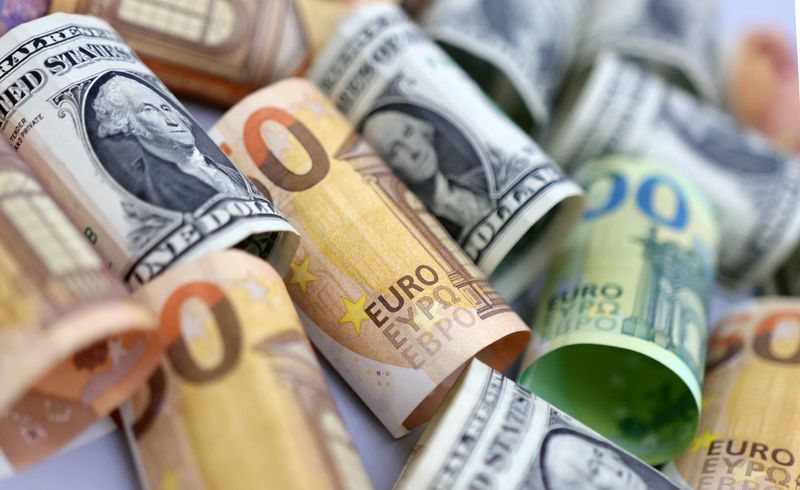Forex
Dollar holds firm as traders bet on cautious Fed in 2025

By Amanda Cooper and Tom Westbrook
LONDON/SINGAPORE (Reuters) – The dollar held firm on Tuesday ahead of an expected interest rate cut in the United States, as traders grow increasingly convinced the Federal Reserve will lower borrowing rates only gradually next year.
The pound was one of the few currencies to rise against the dollar, after data showed British wage growth picked up more strongly than expected in the three months to October, adding to the case that UK rates could take longer to fall than those elsewhere.
The Fed announces its interest rate decision on Wednesday and interest rate futures imply a 94% chance of a cut, even as services-sector activity leapt to a three-year high, according to an S&P Global purchasing managers survey.
The Atlanta Fed’s GDPNow indicator is running at 3.3% for the fourth quarter, and the strength of the economy has been lifting yields and supporting the dollar as traders figure that the neutral setting for rates may be higher than first thought.
“We’re looking for the Fed to indicate more caution over future path of rate cuts. So 25 basis points is a done deal this week, but the key question is, obviously, what happens next year,” MUFG currency strategist Lee Hardman said.
“We do think there’s a higher likelihood that we will see the Fed skip the next meeting in January to leave rates on hold,” he said.
U.S. President-elect Donald Trump takes office in January. He has already promised a raft of measures to impose tariffs on imports from the likes of China, Canada and Mexico, as well as the deportation of millions of undocumented migrants – both of which could contribute to a sustained pickup in inflation and prevent the Fed from cutting rates more deeply.
Fed officials’ median long-run interest rate projection was 2.9% in September. Right now, market pricing implies almost no chance of rates being that low by December next year and only a 30% chance of the Fed Funds rate falling below 3.75% by the end of 2025.
The euro, which is heading for a drop of nearly 5% against the dollar this year, eased 0.2% to $1.04823.
German yields, the benchmark for the euro zone, have risen by around 20 basis points this year, compared with a rise of closer to 55 bps for Treasuries, reflecting the expectation that U.S. rates will fall more slowly than those in Europe.
The gap between U.S. and German 10-year yields is 216 basis points, near its widest in five years, having increased by nearly 70 bps in three months.
RATE DECISIONS AHEAD
Price action across the currency market remained fairly contained on Tuesday, as traders held their fire ahead of the Fed, but also ahead of policy decisions from the Bank of Japan, Bank of England and Norges Bank on Thursday, which are expected to leave their respective rates unchanged. Sweden’s Riksbank also meets on Thursday and is expected to cut rates by as much as half a point.
Sterling rose on Tuesday after data showed regular UK pay rose more quickly than expected in the three months to October.
The BoE has frequently cited wage growth as one of the reasons for caution around cutting rates. A survey of British business activity on Monday pointed to rising price pressures.
The pound was last up 0.1% at $1.2696.
The Canadian dollar, squeezed by falling interest rates and the risk of U.S. tariffs, traded at 4-1/2 year lows around C$1.4277 to the U.S. dollar, after the sudden resignation of Finance Minister Chrystia Freeland on Monday put an unpopular government under more pressure.
The yen strengthened a touch, leaving the dollar down 0.15% at 153.89 per dollar, after six straight days of selling, as markets have scaled back the chances of a Japanese rate hike this week in favour of a move in January.
The Australian and New Zealand dollars are pinned near the year’s lows.
The was last down 0.41% at $0.6345, while the fell 0.39% to $0.576. New Zealand increased its bond issuance forecast for the next few years.

was steady at 7.2892 per dollar, as dour expectations for Chinese economic growth pinned 10-year bond yields near record lows.
Chinese leaders agreed last week to raise the budget deficit to a record 4% of gross domestic product next year, while maintaining an economic growth target of around 5%, two people with knowledge of the matter told Reuters.

 Forex3 years ago
Forex3 years agoForex Today: the dollar is gaining strength amid gloomy sentiment at the start of the Fed’s week

 Forex3 years ago
Forex3 years agoUnbiased review of Pocket Option broker

 Forex3 years ago
Forex3 years agoDollar to pound sterling exchange rate today: Pound plummeted to its lowest since 1985

 Forex3 years ago
Forex3 years agoHow is the Australian dollar doing today?

 Cryptocurrency3 years ago
Cryptocurrency3 years agoWhat happened in the crypto market – current events today

 World3 years ago
World3 years agoWhy are modern video games an art form?

 Commodities3 years ago
Commodities3 years agoCopper continues to fall in price on expectations of lower demand in China

 Economy3 years ago
Economy3 years agoCrude oil tankers double in price due to EU anti-Russian sanctions

























